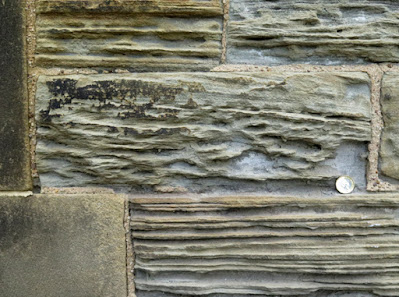 |
| Weathered stone at St. Mary's church |
The exploration of the geology and historic buildings of rural South Yorkshire, without a car, involves some very careful planning at the best of times and, when visiting places like Laughton-en-le-Morthen and Thorpe Salvin – which are only a short distance from Treeton as the crow flies - this involves catching 3 buses each way.
As I had discovered during the COVID-19 Pandemic, having exhausted the interesting places that I could reach on a single bus journey from Treeton, using the 73 and the X54, the X5 route from Dinnington to Sheffield proved to be particularly useful – especially on the return journeys.
For my walk from Shireoaks to South Anston, via the Chesterfield Canal, Lindrick Dale and Anston Stones Wood, I planned my route to end at the Leeds Arms, which was open at the time of my walk on 2nd August 2020 and conveniently has a bus stop immediately outside it.
Having taken a few photos of the Turner Memorial Methodist Church and checked the various bus timetables on my phone while drinking my pint of Abbot Ale, I caught my bus and, rather than travelling all the way back to Sheffield – as I probably would do during normal times – I alighted in Handsworth, where I only had a few minutes to wait for the 73 bus.
The church of St. Mary the Virgin is just over the road from the bus stop and, although I had taken a good look at the interior during the Heritage Open Days festival a few years earlier, I had only taken a few general photos of the exterior and wanted to see its stonework again.
I have encountered numerous older houses in and around Handsworth, where the sandstone generally has a very distinctive ‘ginger nut’ hue on the surface, with a blue/grey colour to the body of the stone; however, my recollection of the oldest visible masonry at St. Mary’s church, in the chancel, was that it had quite a different character.
Since 1825, when the upper stages of the late C12 tower were rebuilt, the north aisle was added in 1833, the south aisle, porch and vestry in 1904 and the choir vestry in 1930. Furthermore, there have been three phases of restoration - in 1869, 1880 and 1934 – and at some stage the lower stages have been rendered and/or covered in a thick paint like coating, as I have seen before at St. Andrew’s church in Bolton upon Dearne.
With very limited time available, I only had time to look at the south porch, which is built of fine grained laminated sandstone, with the occasional block having cross-laminated ripples. Its ‘ginger nut and blue/grey colouration is consistent with the local stone that I have always assumed to be from the large Handsworth Quarries, where it was marketed as Blue Stone.
Where subjected to rising damp, the sandstone blocks have weathered to expose the blue/grey body, with differential weathering highlighting the high silt content – a feature of the finer grained strata in the Pennine Middle Coal Measures Formation, which I had seen as large isolated blocks at the nearby Advanced Manufacturing Park and Waverley Estate.
Having never had the opportunity to see any rock faces in the Handsworth Quarries, which have been redeveloped as a housing estate, I can’t comment on the presence of any orange colouration in the unweathered rock and I would therefore be very interested to see some fresh exposures.










No comments:
Post a Comment